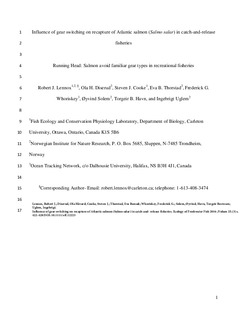Influence of gear switching on recapture of Atlantic salmon (Salmo salar) in catch-and- release fisheries
Lennox, Robert J.; Diserud, Ola Håvard; Cooke, Steven J.; Thorstad, Eva Bonsak; Whoriskey, Frederick G.; Solem, Øyvind; Havn, Torgeir Børresen; Uglem, Ingebrigt
Journal article, Peer reviewed
Accepted version

Åpne
Permanent lenke
http://hdl.handle.net/11250/2480611Utgivelsesdato
2016Metadata
Vis full innførselSamlinger
- Publikasjoner fra CRIStin - NINA [2364]
- Scientific publications [1392]
Sammendrag
Anglers that release Atlantic salmon (Salmo salar) in recreational fisheries do so with the intention that the fish will survive and contribute to succeeding generations. In some instances, salmon that are released may be recaptured, but mechanisms associated with recapture are unclear. To test whether gear avoidance influences recapture rates, we analysed data from tagging programmes in major Norwegian Atlantic salmon fishing rivers to determine how frequently salmon were recaptu red by different gear than that by which they were initially captured (i.e. gear switch). Among 339 salmon captured, externally tagged and released in 2012 and 2013, 46 (14%) were recaptured; 70% of these recaptured salmon exhibited gear switch. To test whether this gear switch percentage could be expected in the absence of gear avoidance, a simulation was conducted, which accounted for variation in catch probability among rivers and across time with different gear types based on comprehensive catch data. Each simulation step provided a simulated rate of gear switch under the null hypothesis of no gear avoidance. A distribution was generated, which described the probability that we would observe 70% gear switch. The simulated results indicated that this rate of gear switch was highly unlikely (P = 0.003) if recapture gear is assumed to be independent of initial capture gear, suggesting that salmon avoided familiar gear types. Changes to behaviour after release, including learned hook avoidance, may explain our observation of gear avoidance by recaptured salmon. fisheries management; recreational fisheries; fish behaviour